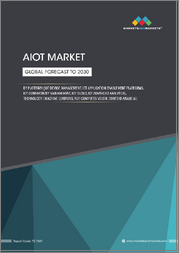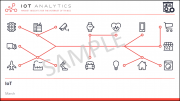
|
시장보고서
상품코드
1629005
IoT 커넥티비티 시장 규모, 점유율, 성장 분석 : 구성요소별, 연결 유형별, 용도별, 최종사용자별, 지역별 - 산업 예측(2025-2032년)IoT Connectivity Market Size, Share, Growth Analysis, By Component (Hardware, Software), By Connectivity Type (Cellular, LPWAN (Low Power Wide Area Network)), By Application, By End-User, By Region - Industry Forecast 2025-2032 |
||||||
IoT 커넥티비티 세계 시장 규모는 2023년 84억 달러로 평가되며, 예측 기간(2025-2032) 동안 연평균 21.7%의 CAGR로 성장하여 2024년 102억 2,000만 달러에서 2032년 491억 9,000만 달러로 성장할 것으로 예상됩니다.
IoT(사물인터넷) 디바이스의 전 세계적인 확산은 향후 몇 년 동안 IoT 커넥티비티에 대한 수요를 크게 증가시킬 것으로 예상되며, IoT 커넥티비티는 애플리케이션과 센서를 포함한 광범위한 IoT 생태계의 핵심 구성요소이기 때문에 통신 통신 기술의 강화는 이 시장 성장에 더욱 박차를 가할 것입니다. 전자제품의 소형화 추세와 다양한 산업 분야에서 IoT 디바이스의 존재감이 확대되면서 이러한 수요를 더욱 증가시킬 것으로 보입니다. 또한, 엣지 컴퓨팅과 인공지능의 부상은 IoT 커넥티비티 제공업체에게 새로운 기회를 제공할 것입니다. 그러나 보안 우려와 표준화 부족 등의 문제가 당분간 시장 발전을 저해할 것으로 예상됩니다. 시장 진입 기업들은 이러한 위험을 피하면서 새로운 트렌드를 활용해야 합니다.
목차
소개
- 조사 목적
- 조사 범위
- 정의
조사 방법
- 정보 조달
- 2차 데이터와 1차 데이터 방법
- 시장 규모 예측
- 시장 가정과 제한
주요 요약
- 세계 시장 전망
- 공급과 수요 동향 분석
- 부문별 기회 분석
시장 역학과 전망
- 시장 개요
- 시장 규모
- 시장 역학
- 성장 촉진요인과 기회
- 성장 억제요인과 과제
- Porters 분석
주요 시장 인사이트
- 핵심성공요인
- 경쟁 정도
- 주요 투자 기회
- 시장 생태계
- 시장 매력 지수(2024년)
- PESTEL 분석
- 거시경제 지표
- 밸류체인 분석
- 가격 분석
- 사례 연구
- 기술의 진보
- 규제 상황
- 특허 분석
- 무역 분석
IoT 커넥티비티 시장 규모 : 구성요소별
- 시장 개요
- 하드웨어
- 센서
- 게이트웨이
- 모듈
- 소프트웨어
- 접속 관리 플랫폼
- 네트워크 관리 플랫폼
- 서비스
- 전문 서비스
- 컨설팅
- 통합과 전개
- 지원과 유지관리
- 매니지드 서비스
IoT 커넥티비티 시장 규모 : 연결 유형별
- 시장 개요
- 셀룰러
- 2G/3G
- 4G/LTE
- 5G
- LPWAN(저전력 광역 네트워크)
- NB-IoT(협대역 IoT)
- LoRa(장거리)
- RF 기반
- Zigbee
- Bluetooth
- 기타
- 위성
- Wi-Fi
IoT 커넥티비티 시장 규모 : 용도별
- 시장 개요
- 스마트 시티
- 교통 관리
- 공공안전
- 산업 자동화
- 제조업
- 공급망 관리
- 헬스케어
- 원격 모니터링
- 자산 추적
- 농업
- 정밀 농업
- 가축 모니터링
- 소매
- 재고 관리
- 고객 경험
IoT 커넥티비티 시장 규모 : 최종사용자별
- 시장 개요
- 기업
- 정부
- 유틸리티
- 헬스케어 제공자
- 소매업체
IoT 커넥티비티 시장 규모
- 북미
- 미국
- 캐나다
- 유럽
- 독일
- 스페인
- 프랑스
- 영국
- 이탈리아
- 기타 유럽
- 아시아태평양
- 중국
- 인도
- 일본
- 한국
- 기타 아시아태평양
- 라틴아메리카
- 브라질
- 기타 라틴아메리카
- 중동 및 아프리카
- GCC 국가
- 남아프리카공화국
- 기타 중동 및 아프리카
경쟁 정보
- 상위 5개사의 비교
- 주요 기업의 시장 포지셔닝(2024년)
- 주요 시장 기업이 채용한 전략
- 시장의 최근 동향
- 기업의 시장 점유율 분석(2024년)
- 주요 기업 개요
- 기업 개요
- 제품 포트폴리오 분석
- 부문별 점유율 분석
- 매출 전년비 비교(2022-2024)
주요 기업 개요
- Cisco Systems, Inc.(USA)
- Huawei Technologies Co., Ltd.(China)
- AT&T Inc.(USA)
- Verizon Communications Inc.(USA)
- Vodafone Group PLC(UK)
- Deutsche Telekom AG(Germany)
- Ericsson(Sweden)
- Telefonica S.A.(Spain)
- Orange S.A.(France)
- China Mobile Ltd.(China)
- Qualcomm Incorporated(USA)
- Intel Corporation(USA)
- Nokia Corporation(Finland)
- SK Telecom Co., Ltd.(South Korea)
- KDDI Corporation(Japan)
- SoftBank Group Corp.(Japan)
- Telus Corporation(Canada)
- BT Group plc(UK)
결론과 추천사항
KSM 25.02.11Global IoT Connectivity Market size was valued at USD 8.4 billion in 2023 and is poised to grow from USD 10.22 billion in 2024 to USD 49.19 billion by 2032, growing at a CAGR of 21.7% during the forecast period (2025-2032).
The global surge in IoT (Internet of Things) device adoption is set to drive the demand for IoT connectivity significantly in the coming years. Enhancements in communication technologies will further fuel this market growth, as IoT connectivity is a core component of the broader IoT ecosystem, including applications and sensors. The trend towards miniaturization in electronics and the expanding presence of IoT devices across various industries will heighten this demand. Additionally, the rise of edge computing and artificial intelligence presents new opportunities for IoT connectivity providers. However, challenges such as security concerns and a lack of standardization are expected to hinder market progress in the foreseeable future. Market participants must navigate these risks while capitalizing on emerging trends.
Top-down and bottom-up approaches were used to estimate and validate the size of the Global Iot Connectivity market and to estimate the size of various other dependent submarkets. The research methodology used to estimate the market size includes the following details: The key players in the market were identified through secondary research, and their market shares in the respective regions were determined through primary and secondary research. This entire procedure includes the study of the annual and financial reports of the top market players and extensive interviews for key insights from industry leaders such as CEOs, VPs, directors, and marketing executives. All percentage shares split, and breakdowns were determined using secondary sources and verified through Primary sources. All possible parameters that affect the markets covered in this research study have been accounted for, viewed in extensive detail, verified through primary research, and analyzed to get the final quantitative and qualitative data.
Global IoT Connectivity Market Segmental Analysis
Global IoT Connectivity Market is segmented by Component, Connectivity Type, Application, End-User and region. Based on Component, the market is segmented into Hardware, Software and Services. Based on Connectivity Type, the market is segmented into Cellular, LPWAN (Low Power Wide Area Network), RF-Based and Others. Based on Application, the market is segmented into Smart Cities, Industrial Automation, Healthcare, Agriculture and Retail. Based on End-User, the market is segmented into Enterprises, Government, Utilities, Healthcare Providers and Retailers. Based on region, the market is segmented into North America, Europe, Asia Pacific, Latin America and Middle East & Africa.
Driver of the Global IoT Connectivity Market
The global IoT connectivity market is significantly driven by the rapid advancements in communication technology, which have transformed in recent years thanks to increasing investments in research and development within the tech sector. These ongoing improvements not only enhance existing communication protocols but also pave the way for innovative solutions in the IoT ecosystem. As more robust and efficient communication technologies emerge, they facilitate better connectivity and integration of IoT devices, thus propelling the growth of the IoT connectivity market. This dynamic landscape continues to evolve, promising exciting opportunities for further innovation and expansion within the industry.
Restraints in the Global IoT Connectivity Market
The global IoT connectivity market faces significant restraints, particularly surrounding interoperability concerns. Many connectivity solutions are not compatible with various IoT devices and systems, which poses a substantial challenge for seamless integration. This lack of compatibility creates obstacles for the widespread adoption of IoT technologies, ultimately impeding the growth and development of the IoT connectivity market. As organizations struggle to unify diverse devices and platforms, the advancement of IoT connectivity is adversely affected, making it critical to address these interoperability issues to foster a more cohesive and efficient IoT ecosystem.
Market Trends of the Global IoT Connectivity Market
The Global IoT Connectivity market is witnessing a significant trend towards the adoption of artificial intelligence (AI) and edge computing, which are reshaping the landscape of IoT solutions. Providers are increasingly integrating these advanced technologies to enhance the functionality and efficiency of IoT devices, enabling them to execute more complex tasks in real-time. This shift not only improves product efficacy but also paves the way for innovative applications across various sectors. As a result, investments in research and development are becoming imperative, driving the evolution of IoT connectivity and positioning companies to capitalize on emerging opportunities in this rapidly evolving ecosystem.
Table of Contents
Introduction
- Objectives of the Study
- Scope of the Report
- Definitions
Research Methodology
- Information Procurement
- Secondary & Primary Data Methods
- Market Size Estimation
- Market Assumptions & Limitations
Executive Summary
- Global Market Outlook
- Supply & Demand Trend Analysis
- Segmental Opportunity Analysis
Market Dynamics & Outlook
- Market Overview
- Market Size
- Market Dynamics
- Drivers & Opportunities
- Restraints & Challenges
- Porters Analysis
- Competitive rivalry
- Threat of substitute
- Bargaining power of buyers
- Threat of new entrants
- Bargaining power of suppliers
Key Market Insights
- Key Success Factors
- Degree of Competition
- Top Investment Pockets
- Market Ecosystem
- Market Attractiveness Index, 2024
- PESTEL Analysis
- Macro-Economic Indicators
- Value Chain Analysis
- Pricing Analysis
- Case Studies
- Technology Advancement
- Regulatory Landscape
- Patent Analysis
- Trade Analysis
Global IoT Connectivity Market Size by Component & CAGR (2025-2032)
- Market Overview
- Hardware
- Sensors
- Gateways
- Modules
- Software
- Connectivity Management Platforms
- Network Management Platforms
- Services
- Professional Services
- Consulting
- Integration and Deployment
- Support and Maintenance
- Managed Services
Global IoT Connectivity Market Size by Connectivity Type & CAGR (2025-2032)
- Market Overview
- Cellular
- 2G/3G
- 4G/LTE
- 5G
- LPWAN (Low Power Wide Area Network)
- NB-IoT (Narrowband IoT)
- LoRa (Long Range)
- RF-Based
- Zigbee
- Bluetooth
- Others
- Satellite
- Wi-Fi
Global IoT Connectivity Market Size by Application & CAGR (2025-2032)
- Market Overview
- Smart Cities
- Traffic Management
- Public Safety
- Industrial Automation
- Manufacturing
- Supply Chain Management
- Healthcare
- Remote Monitoring
- Asset Tracking
- Agriculture
- Precision Farming
- Livestock Monitoring
- Retail
- Inventory Management
- Customer Experience
Global IoT Connectivity Market Size by End-User & CAGR (2025-2032)
- Market Overview
- Enterprises
- Government
- Utilities
- Healthcare Providers
- Retailers
Global IoT Connectivity Market Size & CAGR (2025-2032)
- North America (Component, Connectivity Type, Application, End-User)
- US
- Canada
- Europe (Component, Connectivity Type, Application, End-User)
- Germany
- Spain
- France
- UK
- Italy
- Rest of Europe
- Asia Pacific (Component, Connectivity Type, Application, End-User)
- China
- India
- Japan
- South Korea
- Rest of Asia-Pacific
- Latin America (Component, Connectivity Type, Application, End-User)
- Brazil
- Rest of Latin America
- Middle East & Africa (Component, Connectivity Type, Application, End-User)
- GCC Countries
- South Africa
- Rest of Middle East & Africa
Competitive Intelligence
- Top 5 Player Comparison
- Market Positioning of Key Players, 2024
- Strategies Adopted by Key Market Players
- Recent Developments in the Market
- Company Market Share Analysis, 2024
- Company Profiles of All Key Players
- Company Details
- Product Portfolio Analysis
- Company's Segmental Share Analysis
- Revenue Y-O-Y Comparison (2022-2024)
Key Company Profiles
- Cisco Systems, Inc. (USA)
- Company Overview
- Business Segment Overview
- Financial Updates
- Key Developments
- Huawei Technologies Co., Ltd. (China)
- Company Overview
- Business Segment Overview
- Financial Updates
- Key Developments
- AT&T Inc. (USA)
- Company Overview
- Business Segment Overview
- Financial Updates
- Key Developments
- Verizon Communications Inc. (USA)
- Company Overview
- Business Segment Overview
- Financial Updates
- Key Developments
- Vodafone Group PLC (UK)
- Company Overview
- Business Segment Overview
- Financial Updates
- Key Developments
- Deutsche Telekom AG (Germany)
- Company Overview
- Business Segment Overview
- Financial Updates
- Key Developments
- Ericsson (Sweden)
- Company Overview
- Business Segment Overview
- Financial Updates
- Key Developments
- Telefonica S.A. (Spain)
- Company Overview
- Business Segment Overview
- Financial Updates
- Key Developments
- Orange S.A. (France)
- Company Overview
- Business Segment Overview
- Financial Updates
- Key Developments
- China Mobile Ltd. (China)
- Company Overview
- Business Segment Overview
- Financial Updates
- Key Developments
- Qualcomm Incorporated (USA)
- Company Overview
- Business Segment Overview
- Financial Updates
- Key Developments
- Intel Corporation (USA)
- Company Overview
- Business Segment Overview
- Financial Updates
- Key Developments
- Nokia Corporation (Finland)
- Company Overview
- Business Segment Overview
- Financial Updates
- Key Developments
- SK Telecom Co., Ltd. (South Korea)
- Company Overview
- Business Segment Overview
- Financial Updates
- Key Developments
- KDDI Corporation (Japan)
- Company Overview
- Business Segment Overview
- Financial Updates
- Key Developments
- SoftBank Group Corp. (Japan)
- Company Overview
- Business Segment Overview
- Financial Updates
- Key Developments
- Telus Corporation (Canada)
- Company Overview
- Business Segment Overview
- Financial Updates
- Key Developments
- BT Group plc (UK)
- Company Overview
- Business Segment Overview
- Financial Updates
- Key Developments



















